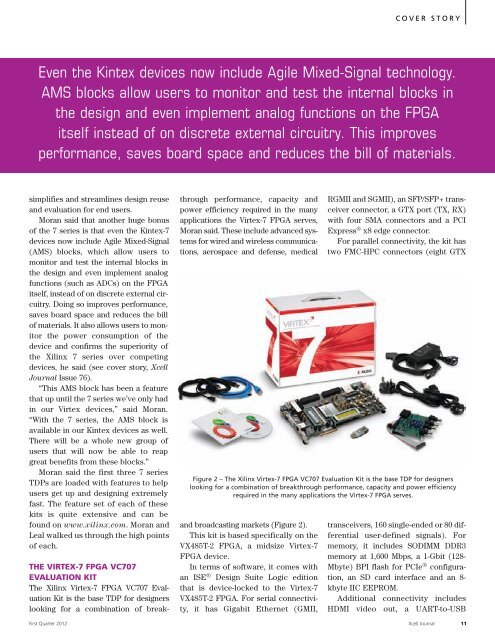Xcell Journal Issue 78: Charge to Market with Xilinx 7 Series ...
Xcell Journal Issue 78: Charge to Market with Xilinx 7 Series ...
Xcell Journal Issue 78: Charge to Market with Xilinx 7 Series ...
Create successful ePaper yourself
Turn your PDF publications into a flip-book with our unique Google optimized e-Paper software.
simplifies and streamlines design reuse<br />
and evaluation for end users.<br />
Moran said that another huge bonus<br />
of the 7 series is that even the Kintex-7<br />
devices now include Agile Mixed-Signal<br />
(AMS) blocks, which allow users <strong>to</strong><br />
moni<strong>to</strong>r and test the internal blocks in<br />
the design and even implement analog<br />
functions (such as ADCs) on the FPGA<br />
itself, instead of on discrete external circuitry.<br />
Doing so improves performance,<br />
saves board space and reduces the bill<br />
of materials. It also allows users <strong>to</strong> moni<strong>to</strong>r<br />
the power consumption of the<br />
device and confirms the superiority of<br />
the <strong>Xilinx</strong> 7 series over competing<br />
devices, he said (see cover s<strong>to</strong>ry, <strong>Xcell</strong><br />
<strong>Journal</strong> <strong>Issue</strong> 76).<br />
“This AMS block has been a feature<br />
that up until the 7 series we’ve only had<br />
in our Virtex devices,” said Moran.<br />
“With the 7 series, the AMS block is<br />
available in our Kintex devices as well.<br />
There will be a whole new group of<br />
users that will now be able <strong>to</strong> reap<br />
great benefits from these blocks.”<br />
Moran said the first three 7 series<br />
TDPs are loaded <strong>with</strong> features <strong>to</strong> help<br />
users get up and designing extremely<br />
fast. The feature set of each of these<br />
kits is quite extensive and can be<br />
found on www.xilinx.com. Moran and<br />
Leal walked us through the high points<br />
of each.<br />
THE VIRTEX-7 FPGA VC707<br />
EVALUATION KIT<br />
The <strong>Xilinx</strong> Virtex-7 FPGA VC707 Evaluation<br />
Kit is the base TDP for designers<br />
looking for a combination of break-<br />
through performance, capacity and<br />
power efficiency required in the many<br />
applications the Virtex-7 FPGA serves,<br />
Moran said. These include advanced systems<br />
for wired and wireless communications,<br />
aerospace and defense, medical<br />
and broadcasting markets (Figure 2).<br />
This kit is based specifically on the<br />
VX485T-2 FPGA, a midsize Virtex-7<br />
FPGA device.<br />
In terms of software, it comes <strong>with</strong><br />
an ISE ® Design Suite Logic edition<br />
that is device-locked <strong>to</strong> the Virtex-7<br />
VX485T-2 FPGA. For serial connectivity,<br />
it has Gigabit Ethernet (GMII,<br />
COVER STORY<br />
Even the Kintex devices now include Agile Mixed-Signal technology.<br />
AMS blocks allow users <strong>to</strong> moni<strong>to</strong>r and test the internal blocks in<br />
the design and even implement analog functions on the FPGA<br />
itself instead of on discrete external circuitry. This improves<br />
performance, saves board space and reduces the bill of materials.<br />
RGMII and SGMII), an SFP/SFP+ transceiver<br />
connec<strong>to</strong>r, a GTX port (TX, RX)<br />
<strong>with</strong> four SMA connec<strong>to</strong>rs and a PCI<br />
Express ® x8 edge connec<strong>to</strong>r.<br />
For parallel connectivity, the kit has<br />
two FMC-HPC connec<strong>to</strong>rs (eight GTX<br />
Figure 2 – The <strong>Xilinx</strong> Virtex-7 FPGA VC707 Evaluation Kit is the base TDP for designers<br />
looking for a combination of breakthrough performance, capacity and power efficiency<br />
required in the many applications the Virtex-7 FPGA serves.<br />
transceivers, 160 single-ended or 80 differential<br />
user-defined signals). For<br />
memory, it includes SODIMM DDR3<br />
memory at 1,600 Mbps, a 1-Gbit (128-<br />
Mbyte) BPI flash for PCIe ® configuration,<br />
an SD card interface and an 8kbyte<br />
IIC EEPROM.<br />
Additional connectivity includes<br />
HDMI video out, a UART-<strong>to</strong>-USB<br />
First Quarter 2012 <strong>Xcell</strong> <strong>Journal</strong> 11

















